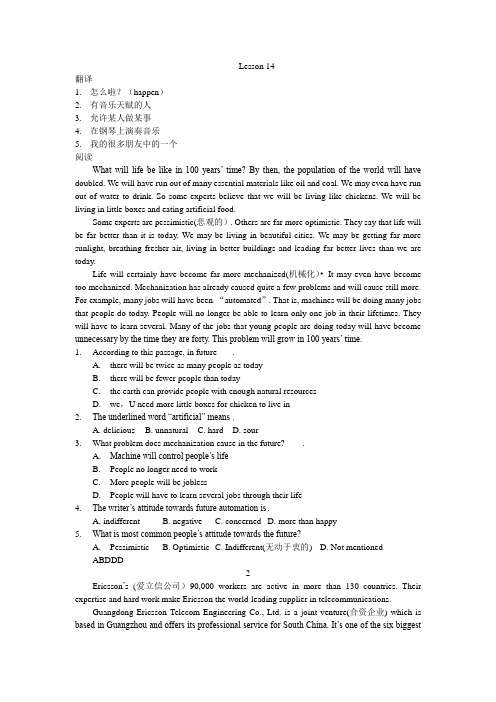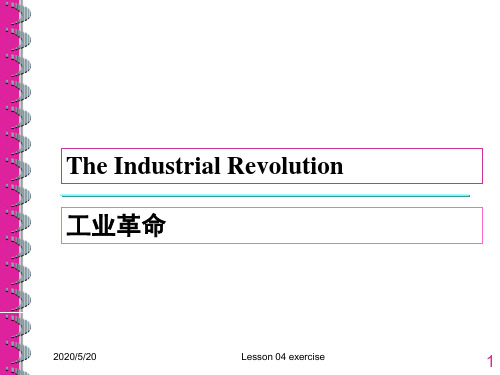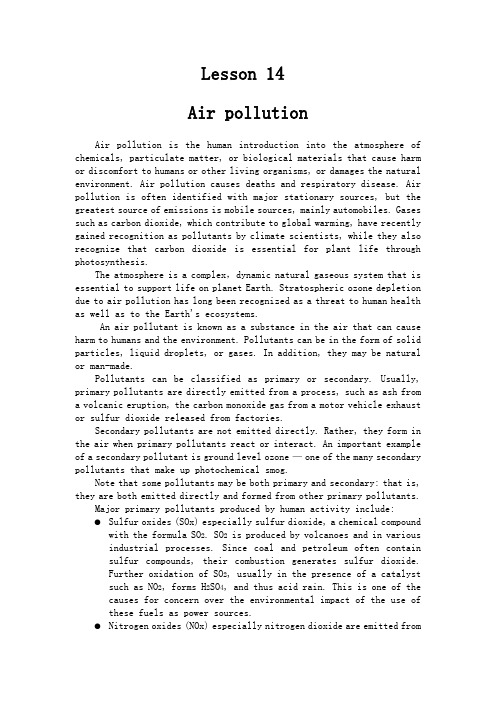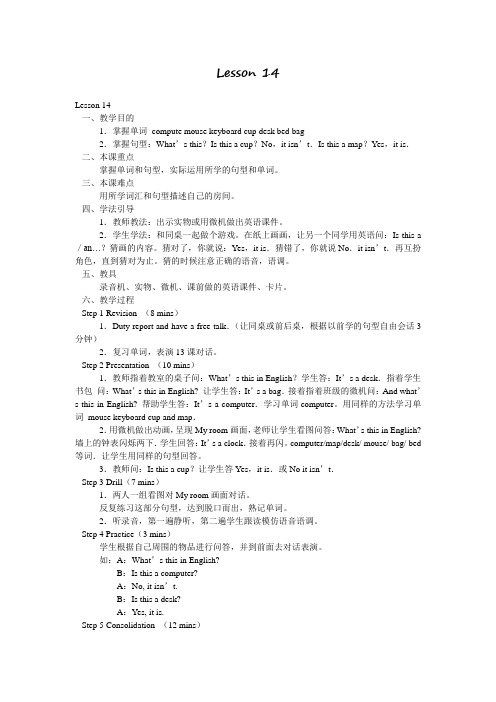自考英语笔译教材lesson 14 ex
- 格式:ppt
- 大小:283.00 KB
- 文档页数:11


Lesson 14翻译1.怎么啦?(happen)2.有音乐天赋的人3.允许某人做某事4.在钢琴上演奏音乐5.我的很多朋友中的一个阅读What will life be like in 100 years’ time? By then, the population of the world will have doubled. We will have run out of many essential materials like oil and coal. We may even have run out of water to drink. So some experts believe that we will be living like chickens. We will be living in little boxes and eating artificial food.Some experts are pessimistic(悲观的). Others are far more optimistic. They say that life will be far better than it is today. We may be living in beautiful cities. We may be getting far more sunlight, breathing fresher air, living in better buildings and leading far better lives than we are today.Life will certainly have become far more mechanized(机械化)•It may even have become too mechanized. Mechanization has already caused quite a few problems and will cause still more. For example, many jobs will have been “automated”. That is, machines will be doing many jobs that people do today. People will no longer be able to learn only one job in their lifetimes. They will have to learn several. Many of the jobs that young people are doing today will have become unnecessary by the time they are forty. This problem will grow in 100 years’ time.1. According to this passage, in future .A. there will be twice as many people as todayB. there will be fewer people than todayC. the earth can provide people with enough natural resourcesD. we,U need more little boxes for chicken to live in2. The underlined word “artificial” means .A. deliciousB. unnaturalC. hardD. sour3. What problem does mechanization cause in the future? .A. Machine will control people’s lifeB. People no longer need to workC. More people will be joblessD. People will have to learn several jobs through their life4. The writer’s attitude towards future automation is.A. indifferentB. negativeC. concernedD. more than happy5. What is most common people’s attitude towards the future?A. PessimisticB. OptimisticC. Indifferent(无动于衷的)D. Not mentionedABDDD2Ericsson’s (爱立信公司)90,000 workers are active in more than 130 countries. Their expertise and hard work make Ericsson the world-leading supplier in telecommunications.Guangdong Ericsson Telecom Engineering Co., Ltd. is a joint venture(合资企业) which is based in Guangzhou and offers its professional service for South China. It’s one of the six biggestbases of Ericsson, as big as the bases in Singapore, New York and London.With fast growth of our business, we now invite some managers, engineers and other personnel to join us for the following ten openings(招聘岗位):TRANSMISSION ENGINEERSSUPPORT ENGINEERSIMPLEMENTATION ENGINEERSTEST ENGINEERSPROGRAMME ENGINEERSWORKPLACE MANAGERMARKETING MANAGERLABORATORY MANAGERRECEPTION SECRETARYBUS DRIVERIf you want to join us, you should be:—excellent in related openings;—good in oral and written English;—college graduates (except bus driver);—of good team work ability.Interested applicants are welcome to send your application with detailed resume in both Chinese and English, copy of education certificate(证书)and ID card(身份证),current salary and expected, contact number 510665 Guangdong Ericsson Co., Ltd. Ericsson Building, Tianhe Guangzhou, and welcome to visit our company to talk with us directly.1. Ericsson has business.A. only in ChinaB. in China based GuangzhouC. on over 130 countriesD. in South China.2. Why does Ericsson want to invite some personnel?A. They want to build a base in GuangzhouB. They want to develop a new programmeC. Their workers are not active enoughD. Their business grows very fast3. How many kinds of engineers does Ericsson want to invite? .A. FiveB. SixC. EightD.Ten4. If you are a very good bus driver , you want to be invited by Ericsson,you should______A. join a football teamB. be a college graduateC. can speak EnglishD. have English speaking and writing ability5. This advertisement is most possibly from a newspaper in______A. SingaporeB. New YorkC. LondonD. GuangzhouCDADD完形填空June was lying by the Olympic size swimming pool in her new swimsuit. She was really hot and dived into water. 1 else was in the pool. The refreshing water cooled her body immediately, which 2 her to continue doing some laps there.Now having swum in the past several years and being a bit out of 3 , June began to tire 4 . “Ah, no pains, no gains,” June thought to herself. June 5 to swim, realizing her head was 6 . Breathing became difficult. Her vision wasn’t so 7 . She saw the lifeguard and acouple of others around the pool. No sense in 8 anyone. She continued.She found 9 in the middle of the pool. Deciding not to make a scene, she continued to swim. 10 , she made it to the other side of the pool. Nausea (恶心), weakness and exhaustion (精疲力竭) 11 it difficult for June to get out of the pool. 12 she stood, her body slowly shook back and forth, Losing her 13 .Realizing she needed help but 14 to even say anything, she 15 the pool side and stood there. Several minutes later she had enough energy to only 16 her body up out of the pool. Sitting at the side of the pool with her feet in the water she felt that someone was 17 at her. It was the lifeguard. June was just able to 18 her hand, telling him she was okay.Have you ever found yourself in a 19 where you’re in trouble and you don’t ask for help? There is nothing 20 in asking for help. June could have drowned. However, we all have the tendency, as June did.1. A someone B. No one C Anyone D. Everyone2. A. encouraged B. advised C. allowed D. forced3. A. mind B. time C. shape D. fashion4. A. hardly B. easily C. falsely D. unexpectedly5. A. remained B. stopped C. happened D. continued6. A. hurting B. hurt C. suffering D. suffered7. A. sure B. clean C. clear D. poor8. A. bothering B. interrupting C. attracting D. helping9. A. one B. it C. her D. herself10. A. Lastly B. Finally C. Suddenly D. Surprisingly11. A. found B. let C. made D. felt12. A. Since B. As C. Until D. Unless13. A. life B. courage C. chance D. balance14. A. unable B. ready C. proud D. afraid15. A. came across B. lay on C. leaned against D. fought with16. A. pull B. push C. raised D. rise17. A laughing B. staring C. glimpsing D. shrugging18. A. hold B. lend C. move D. wave19. A. atmosphere B. condition C. situation D. environment20. A. difficult B. different C. useful D. wrong1~5 BACBD 6~10 ACADB 11~15 CBDAC 16~20 ABDCD【New words and expressions】(6)turn n. 行为,举止deserve v. 应得到,值得lawyer n. 律师bank n. 银行salary n. 工资immediately adv. 立刻★turn n.(帮助或损害他人的)举动、行为Yesterday George did me a good/an ill turn. 乔治昨天做了一件对我有利/不利的事。

新观点第四册课文翻译及学习笔录Lesson14【课文】First listen and then answer the following question.听录音,而后回答以下问题。
Why do small errors make it impossible to predictthe weather system with a high degree of accuracy?Beyond two or three days, the world's best weather forecasts are speculative, and beyond six or seven theyare worthless.The Butterfly Effect is the reason. For small pieces of weather -- and to a global forecaster, small can mean thunderstorms and blizzards -- any prediction deteriorates rapidly. Errors and uncertainties multiply, cascadingupward through a chain of turbulent features, from dustdevils and squalls up to continent-size eddies that onlysatellites can see.The modern weather models work with a grid of points of the order of sixty miles apart, and even so, some starting data has to be guessed, since ground stations and satellites cannot see everywhere. But suppose the earth could be covered with sensors spaced one foot apart, rising at one-foot intervals all the way to the top of the atmosphere. Suppose every sensor gives perfectly accurate readings of temperature, pressure, humidity, and any other quantity a meteorologist would want. Precisely at noon an infinitely powerful computer takes all the data and calculates what will happen at each point at 12.01, then 120.2, then 12.03...The computer will still be unable to predict whether Princeton, New Jersey, will have sun or rain on a day one month away. At noon the spaces between the sensors will hide fluctuations that the computer will not know about, tiny deviations from the average. By 12.01, those fluctuationswill already have created small errors one foot away. Soonthe errors will have multiplied to the ten-foot scale, and soon up to the size of the globe.JAMES GLEICK, Chaos【New words and expressions生词和短语】forecast n.预告speculative adj.推测的blizzard n.狂风雪deteriorate v.变坏multiply v.增添cascade v.瀑布似地落下turbulent adj.狂暴的dust devil小尘暴,尘旋风squall n.狂风eddy n.旋涡grid n.坐标方格sensor n.传感器humidity n.温度meteorologist n.气象学家Princeton n.普林斯顿(美国城市名)New Jersey n.新泽西(美国州名)fluctuation n.起伏,颠簸deviation n.误差【课文说明】1.beyond two or three days,超出两三天。


Lesson 14Air pollutionAir pollution is the human introduction into the atmosphere of chemicals, particulate matter, or biological materials that cause harm or discomfort to humans or other living organisms, or damages the natural environment. Air pollution causes deaths and respiratory disease. Air pollution is often identified with major stationary sources, but the greatest source of emissions is mobile sources, mainly automobiles. Gases such as carbon dioxide, which contribute to global warming, have recently gained recognition as pollutants by climate scientists, while they also recognize that carbon dioxide is essential for plant life through photosynthesis.The atmosphere is a complex,dynamic natural gaseous system that is essential to support life on planet Earth. Stratospheric ozone depletion due to air pollution has long been recognized as a threat to human health as well as to the Earth's ecosystems.An air pollutant is known as a substance in the air that can cause harm to humans and the environment. Pollutants can be in the form of solid particles, liquid droplets, or gases. In addition, they may be natural or man-made.Pollutants can be classified as primary or secondary. Usually, primary pollutants are directly emitted from a process, such as ash from a volcanic eruption, the carbon monoxide gas from a motor vehicle exhaust or sulfur dioxide released from factories.Secondary pollutants are not emitted directly. Rather, they form in the air when primary pollutants react or interact. An important example of a secondary pollutant is ground level ozone —one of the many secondary pollutants that make up photochemical smog.Note that some pollutants may be both primary and secondary: that is, they are both emitted directly and formed from other primary pollutants.Major primary pollutants produced by human activity include:●Sulfur oxides (SOx) especially sulfur dioxide, a chemical compoundwith the formula SO2. SO2 is produced by volcanoes and in various industrial processes. Since coal and petroleum often contain sulfur compounds, their combustion generates sulfur dioxide.Further oxidation of SO2, usually in the presence of a catalyst such as NO2, forms H2SO4, and thus acid rain. This is one of the causes for concern over the environmental impact of the use of these fuels as power sources.●Nitrogen oxides (NOx) especially nitrogen dioxide are emitted fromhigh temperature combustion. Can be seen as the brown haze dome above or plume downwind of cities. Nitrogen dioxide is the chemical compound with the formula NO2. It is one of the several nitrogen oxides. This reddish-brown toxic gas has a characteristic sharp, biting odor. NO2 is one of the most prominent air pollutants.●Carbon monoxide - is a colorless, odorless, non-irritating butvery poisonous gas. It is a product by incomplete combustion of fuel such as natural gas, coal or wood. Vehicular exhaust is a major source of carbon monoxide.●Carbon dioxide (CO2),a greenhouse gas emitted form combustion.●Volatile organic compounds VOCs are an important outdoor airpollutant. In this field they are often divided into the separate categories of methane (CH4) and non-methane (NMVOCs). Methane is an extremely efficient greenhouse gas which contributes to enhanced global warming. Other hydrocarbon VOCs are also significant greenhouse gases via their role in creating ozone and in prolonging the life of methane in the atmosphere, although the effect varies depending on local air quality. Within the NMVOCs, the aromatic compounds benzene, toluene and xylene are suspected carcinogens and may lead to leukemia through prolonged exposure.1,3-butadiene is another dangerous compound which is often associated with industrial uses.●Particulate matter Particulates, alternatively referred to asparticulate matter (PM) or fine particles, are tiny particles of solid or liquid suspended in a gas. In contrast, aerosol refers to particles and the gas together. Sources of particulate matter can be man made or natural. Some particulates occur naturally, originating from volcanoes, dust storms, forest and grassland fires, living vegetation, and sea spray. Human activities, such as the burning of fossil fuels in vehicles, power plants and various industrial processes also generate significant amounts of aerosols. Averaged over the globe, anthropogenic aerosols—those made by human activities—currently account for about 10 percent of the total amount of aerosols in our atmosphere. Increased levels of fine particles in the air are linked to health hazards such as heart disease, altered lung function and lung cancer.●Toxic metals, such as lead, cadmium and copper.●Chlorofluorocarbons (CFCs), harmful to the ozone layer emittedfrom products currently banned from use.●Ammonia (NH3),emitted from agricultural processes. Ammonia is acompound with the formula NH3. It is normally encountered as a gas with a characteristic pungent odor. Ammonia contributes significantly to the nutritional needs of terrestrial organisms by serving as a precursor to foodstuffs and fertilizers. Ammonia,either directly or indirectly, is also a building block for the synthesis of many pharmaceuticals. Although in wide use, ammonia is both caustic and hazardous.●Odors,such as from garbage, sewage, and industrial processes.● Radioactive pollutants produced by nuclear explosions, warexplosives, and natural processes such as the radioactive decay of radon.Secondary pollutants include:●Particulate matter formed from gaseous primary pollutants andcompounds in photochemical smog. Smog is a kind of air pollution;the word “smog” is a portmanteau of smoke and fog. Classic smog results from large amounts of coal burning in an area caused bya mixture of smoke and sulfur dioxide. Modern smog does not usuallycome from coal but from vehicular and industrial emissions that are acted on in the atmosphere by sunlight to form secondary pollutants that also combine with the primary emissions to form photochemical smog.●Ground level ozone (O3) formed from NOx and VOCs. Ozone (O3) isa key constituent of the troposphere (it is also an importantconstituent of certain regions of the stratosphere commonly known as the Ozone layer). Photochemical and chemical reactions involving it drive many of the chemical processes that occur in the atmosphere by day and by night. At abnormally high concentrations brought about by human activities (largely the combustion of fossil fuel), it is a pollutant, and a constituent of smog.●Peroxyacetyl nitrate (PAN) - similarly formed from NOx and VOCs.Minor air pollutants include:● A large number of minor hazardous air pollutants. Some of theseare regulated in USA under the Clean Air Act and in Europe under the Air Framework Directive.● A variety of persistent organic pollutants, which can attach toparticulate matter.Persistent organic pollutants (POPs) are organic compounds that are resistant to environmental degradation through chemical, biological, and photolytic processes. Because of this, they have been observed to persist in the environment, to be capable of long-range transport, bioaccumulate in human and animal tissue, biomagnify in food chains, and to have potential significant impacts on human health and the environment.14课:空气污染空气污染是人类引入氛围的化学品、颗粒、或生物材料,造成损害或不舒服,人类或其他生物破坏的自然环境。

Lesson 14Lesson 14一、教学目的1.掌握单词compute mouse keyboard cup desk bed bag2.掌握句型:What’s this?Is this a cup?No,it isn’t.Is this a map?Yes,it is.二、本课重点掌握单词和句型,实际运用所学的句型和单词。
三、本课难点用所学词汇和句型描述自己的房间。
四、学法引导1.教师教法:出示实物或用微机做出英语课件。
2.学生学法:和同桌一起做个游戏。
在纸上画画,让另一个同学用英语问:Is this a/an…?猜画的内容。
猜对了,你就说:Yes,it is.猜错了,你就说No.it isn’t.再互扮角色,直到猜对为止。
猜的时候注意正确的语音,语调。
五、教具录音机、实物、微机、课前做的英语课件、卡片。
六、教学过程Step 1 Revision (8 mins)1.Duty report and have a free talk.(让同桌或前后桌,根据以前学的句型自由会话3分钟)2.复习单词,表演13课对话。
Step 2 Presentation (10 mins)1.教师指着教室的桌子问:What’s this in English?学生答:It’s a desk.指着学生书包问:What’s this in English? 让学生答:It’s a bag.接着指着班级的微机问:And what’s this in English? 帮助学生答:It’s a computer.学习单词computer。
用同样的方法学习单词mouse keyboard cup and map.2.用微机做出动画,呈现My room画面,老师让学生看图问答:What’s this in English? 墙上的钟表闪烁两下.学生回答:It’s a clock.接着再闪。
computer/map/desk/ mouse/ bag/ bed 等词.让学生用同样的句型回答。
英汉翻译教程自考题-14(总分:100.00,做题时间:90分钟)一、{{B}}Ⅰ.Multiple Choice{{/B}}(总题数:0,分数:0.00)二、{{B}}A. Directions: This part consists of ten sentences, each followed by four different versions marked A, B, C and D. Choose the best translation of the original statement in terms of meaning and expressiveness.{{/B}}(总题数:10,分数:20.00) 1.Spider are not insects, as many people think, nor even nearly related to them. ______∙ A.正如许多人认为的那样,蜘蛛并不是昆虫,甚至和昆虫一点关系都没有。
∙ B.蜘蛛并不像许多人认为的那样是昆虫,它和昆虫一点关系都没有。
∙ C.正如许多人认为的那样,蜘蛛就是昆虫,和昆虫密不可分。
∙ D.蜘蛛正像许多人认为的那样不是昆虫,它和昆虫一点关系都没有。
(分数:2.00)A.B. √C.D.解析:[解析] 本题考查as和nor的用法。
(1)as作连词时,表示“a fact which为……之事实”。
在英文中为了避免重复以及出于简练考虑而省略一些词语。
本题句中as前面主句中有not,因此as从句省略了not,译时应译出否定含义,即B项的“并不像许多人认为……”。
据此可排除A、C、D项。
(2)nor可表示“也不”,常用于否定句中,位于句首时助动词或情态动词等词须放于主语前面,即倒装。
例如,Jack does not like Mary,nor do I而本题句中nor后边省略了are they,所以此处应是否定意思,因此C选项因有“和昆虫密不可分”这样肯定的意思而排除。
《Lesson 14》学历案一、学习主题Lesson 14 的深入学习与理解二、学习目标1、掌握 Lesson 14 中的核心词汇和短语,能够准确拼写和运用。
2、理解课文中的重点句型和语法结构,能够熟练进行句式转换和造句。
3、能够流利地朗读课文,并准确理解课文的含义。
4、通过对课文的学习,培养阅读理解和语言表达的能力。
三、学习重难点(一)重点1、重点词汇:_____ 、_____ 、_____ 等。
2、重点句型:_____ 、_____ 、_____ 等。
3、语法要点:_____ 、_____ 、_____ 等。
(二)难点1、某些词汇的特殊用法及搭配。
2、复杂句型的理解和运用。
3、语法规则在实际语境中的正确应用。
四、学习资源1、教材:《_____》教材中的 Lesson 14 内容。
2、在线学习平台:提供相关的课文朗读音频、练习题及解析。
3、学习工具:词典、笔记本等。
五、学习过程(一)课前预习1、通读 Lesson 14 的课文,标注出生词和不理解的句子。
2、查阅词典,尝试理解生词的含义,并记录在笔记本上。
3、预习课文中的语法点,通过简单的例句初步了解其用法。
(二)课堂学习1、词汇学习教师讲解重点词汇的发音、拼写、词义和用法,并进行示范造句。
学生跟读、模仿,进行词汇练习,如拼写、填空、造句等。
小组讨论词汇的拓展用法,分享自己的理解和记忆方法。
2、句型学习教师分析重点句型的结构和语法规则,结合课文中的例句进行讲解。
学生进行句型转换、模仿造句等练习,加深对句型的理解和运用。
创设情境,让学生运用重点句型进行对话练习,提高口语表达能力。
3、课文学习教师播放课文朗读音频,学生跟读,注意语音、语调的模仿。
学生分组朗读课文,教师进行指导和纠正。
教师对课文进行详细讲解,帮助学生理解课文的含义、篇章结构和写作意图。
学生提出问题,教师进行解答,确保学生对课文内容的掌握。
4、语法学习教师系统讲解课文中涉及的语法知识,通过例句和练习进行巩固。